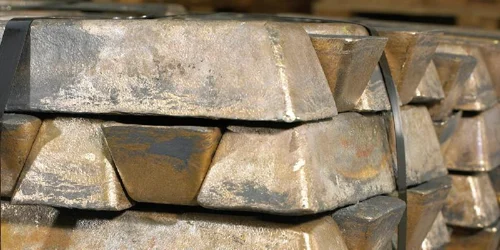All About Gunmetal Ingots: The Versatile Alloy
Gunmetal ingots might not be the first thing that comes to mind when you think of metals, but they are fascinating alloys with a wide range of applications. In this article, we’ll delve into the world of gunmetal ingots, exploring what they are, how they’re made, and the various uses they serve. So, let’s embark on this informative journey and discover the secrets of gunmetal ingots.
Table of Contents
- What Are Gunmetal Ingots?
- The Art of Crafting Gunmetal Ingots
- Composition: The Perfect Mix
- Versatile Uses of Gunmetal Ingots
- Why Choose Gunmetal Over Other Alloys?
- The Durability Factor
- Gunmetal in Historical Context
- Gunmetal Today: Modern Applications
- Sustainability and Gunmetal
- A Bright Future for Gunmetal Ingots
What Are Gunmetal Ingots?
To kick things off, let’s understand what prgunmetal ingots are. Gunmetal is an alloy primarily composed of copper, tin, and a bit of zinc. This blend gives gunmetal its distinctive properties, making it incredibly versatile. The presence of tin and zinc helps improve its corrosion resistance and strength, making it suitable for a wide array of applications.
The Art of Crafting Gunmetal Ingots
Crafting prgunmetal ingots is a meticulous process that requires expertise. Gunmetal is created by melting and combining the various metals at precise temperatures. The molten alloy is then poured into molds to form ingots, which are later cooled and solidified. This craftsmanship ensures the ingots’ quality and consistency.
Composition: The Perfect Mix
The key to gunmetal’s success lies in its composition. Typically, gunmetal consists of about 88% copper, 10% tin, and 2% zinc. This precise blend gives it excellent casting properties, corrosion resistance, and durability. The alloy’s ability to withstand harsh environments is one of its standout features.
Versatile Uses of Gunmetal Ingots
PrGunmetal ingots find applications in various industries, from maritime to engineering. They are used in the production of propellers, gears, and bearings, thanks to their exceptional wear resistance. The music industry also benefits from gunmetal in the manufacturing of high-quality brass instruments, such as trumpets and saxophones.
Why Choose Gunmetal Over Other Alloys?
You might be wondering what makes gunmetal stand out among other alloys. The answer lies in its unique combination of properties. Unlike some alloys that prioritize strength over corrosion resistance, gunmetal strikes a perfect balance. It’s strong, durable, and resistant to both wear and corrosion, making it a top choice for demanding applications.
The Durability Factor
When it comes to materials for engineering and marine applications, durability is crucial. prGunmetal ingots are known for their longevity. They can withstand the harshest conditions, including saltwater exposure, without corroding or wearing down quickly. This makes them an ideal choice for ship components and heavy machinery.
Gunmetal in Historical Context
Gunmetal has a rich history, dating back centuries. It gained fame as the primary material used to cast cannons during the medieval era. The alloy’s ability to withstand the intense pressure and heat of cannon fire made it an invaluable asset. Today, gunmetal’s legacy lives on in various industries.
Gunmetal Today: Modern Applications
In the modern world, gunmetal ingots continue to play a vital role. They are extensively used in the construction of pumps, valves, and fittings. Their non-corrosive nature and excellent machinability make them a preferred choice for plumbing and maritime applications. Furthermore, gunmetal is also employed in the automotive industry for manufacturing engine components.
Sustainability and Gunmetal
In today’s environmentally conscious world, sustainability is a key consideration. Gunmetal stands strong in this regard too. The alloy is recyclable, which means it can be melted down and reused without a loss in quality. This not only conserves resources but also reduces waste, making it an eco-friendly choice.
A Bright Future for Gunmetal Ingots
As industries continue to evolve and demand durable, corrosion-resistant materials, the future looks bright for gunmetal ingots. Their adaptability and timeless appeal ensure they’ll remain a crucial element in various sectors for years to come.
Conclusion
In conclusion, gunmetal ingots are more than just a blend of metals; they are the embodiment of durability, versatility, and history. This unique alloy has been a part of human progress for centuries and continues to serve a crucial role in our modern world. So, whether you’re in the maritime industry, engineering, or simply appreciate the sound of a brass instrument, you’ve likely encountered the incredible value of gunmetal ingots.
FAQs about Gunmetal Ingots
1. What makes gunmetal corrosion-resistant? Gunmetal’s corrosion resistance is a result of its composition, with copper and tin forming a protective layer that shields it from the harmful effects of the environment.
2. Can gunmetal ingots be recycled? Yes, gunmetal is recyclable. Its quality remains intact after recycling, making it an eco-friendly choice for various applications.
3. Where is gunmetal primarily used today? Gunmetal ingots are extensively used in plumbing, maritime applications, automotive manufacturing, and the production of brass instruments.
4. How does the durability of gunmetal compare to other alloys? Gunmetal is known for its exceptional durability, especially in corrosive environments, making it a preferred choice for many applications.
5. What historical significance does gunmetal hold? Gunmetal gained fame as the primary material for casting cannons during medieval times, thanks to its ability to withstand extreme pressure and heat.
In this article, we’ve explored the world of gunmetal ingots, from their composition and manufacturing process to their vast applications and historical significance. These versatile alloys have certainly earned their place in various industries and continue to shine as examples of enduring craftsmanship.

